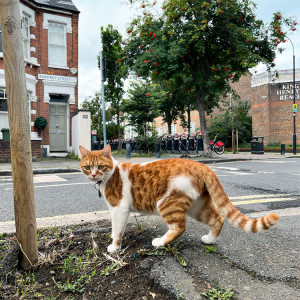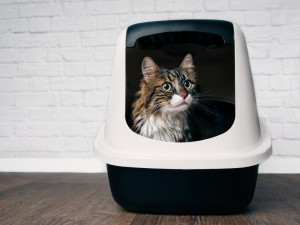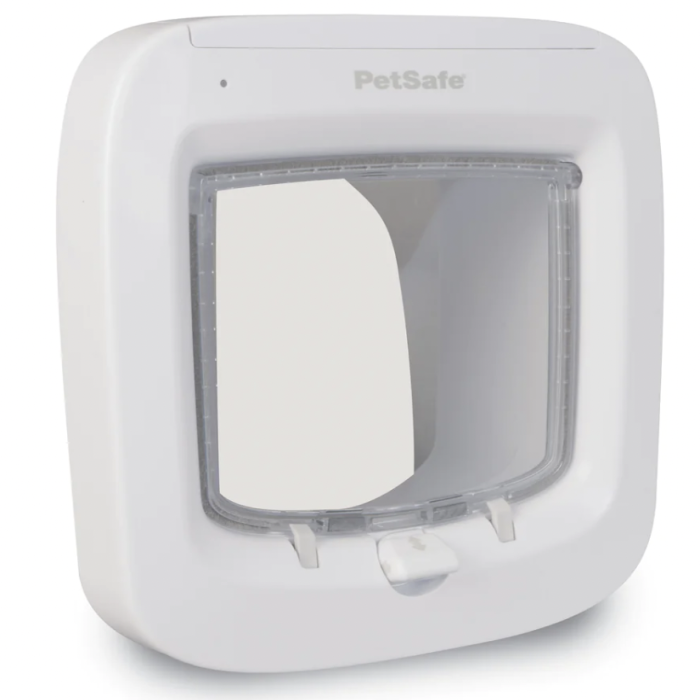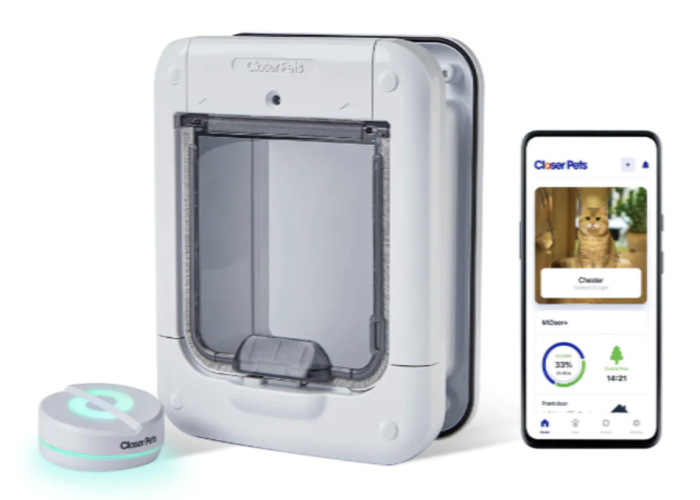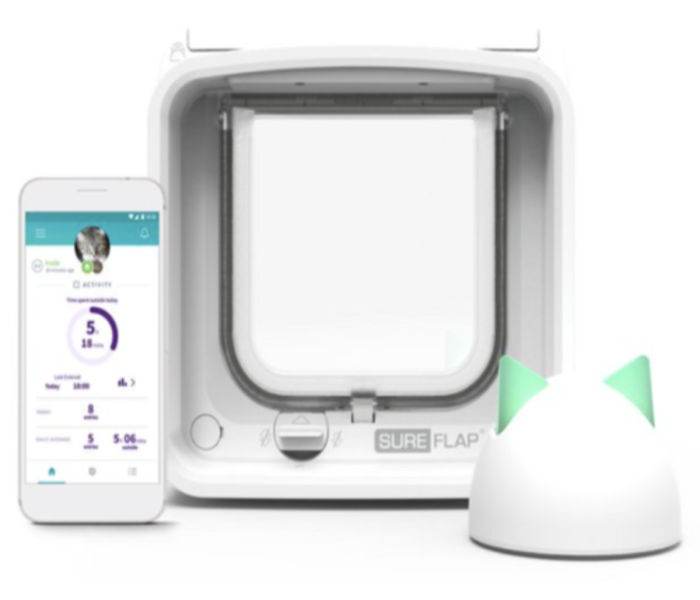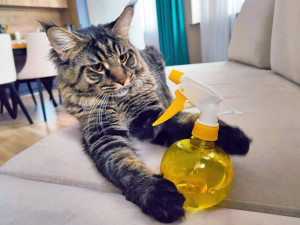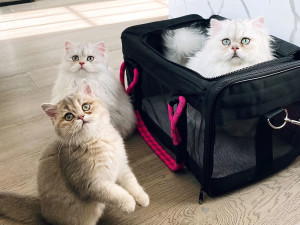Microchip Cat Flaps: Unlocking the Secrets
Give your cat a key to the outside world

Share Article
Many cat parents deliberate with the ‘should they or shouldn’t they’ question when it comes to letting our feline friends roam free outside. But in the UK, up to 70% of domestic catsopens in a new tab live an indoor/outdooropens in a new tab hybrid lifestyle, with charities such as Cats Protectionopens in a new tab and Batterseaopens in a new tab actively recommending that cats have access to the great outdoors for their well-being. But how best to give your cat that freedom: leave a window open (cold, security risks, insects), let your cat in and out on demand (will they ever make up their mind?) or, as many cat parents do, install a cat flap that allows them free access?
The history of cat flaps
Did you know there’s a commonly held belief that Sir Issac Newton was the creator of the cat flap? The story goes that Newton created two holes in his dooropens in a new tab (one for his cat and one for his kitten) and draped a cloth over them as a flap after his felines kept ruining photosensitive experiments by opening the door and letting light in. But even before this, ‘cat holes’ were a thing, with one of the world’s oldest cat holes at Exeter Cathedral dating back 400 years. Diane Walker, cathedral historian and author, said in an articleopens in a new tab that Bishop Cotton cut the hole to allow his cat to “catch rats and mice”.

littleKin™ is Kinship’s home just for puppy and kitten parents. Bop over to check out expert advice, new pet tools, and special deals—all curated for your newest family member.
opens in a new tabThe cat hole was also mentioned as far back as Chaucer’sopens in a new tab late-14th-century The Canterbury Tales, and used by a servant to peek into a room.
Modern iterations
As time went on, the cat hole became a cat flap, as people started to attach material to give more privacy (I’m looking at you, peeping servant) and reduce the draughts. The DIY flaps then advanced to plastic inserts that would allow the average-size cat to pass through. However, this meant any other cat could enter the home, too, leading to many stressed cats and cat parents. A large research projectopens in a new tab in 2013 by the Royal Veterinary College and Bristol and Lincoln Universities showed that many cats will intrude into the houses of others unbeknown to the humans.
The basic plastic insert option with a dial or clip to be locked or open is still a popular choice today, and often comes with the option to set it in different ways: exit/entry, entry only, exit only. This gives cat parents the choice to keep their felines in or out for allocated periods of time (eg, you’re mopping the floor and don’t want little paw prints all over it).
Then came the magnet flap: the cat wears a small magnet on their collar that ‘unlocks’ the flap as they put their head into the porch. However, lose the collar, lose the key – and many a cat has been stranded outside as a result. The magnet also has a habit of picking up debris while the cat is roaming, and it’s not unusual to find something metal attached to your cat’s collar.
And now? The big invention that revolutionised the market: the microchip cat flap.
How do microchip cat flaps work?
In 2017, Sure Petcare – one of the market leaders for innovative pet products – announced its Cat Door Connect. It was marketed as ‘the most advanced cat flap ever’, which allowed cat parents to remotely control the cat flap from a smartphone or tablet, while monitoring each cat’s daily habits and activity using an app.
Most microchip cat flaps use radio frequency identification (RFID) technology, which works by reading your cat’s unique microchip ID without the need for a collar or accessory. When your cat approaches the flap, it will respond by allowing only your cat to enter. Some manufacturers also offer a ‘tag system’, which can be attached to collars – but many a collar is lost while cats are roaming their territory.
However, these tags actually won’t be necessary come June. New lawsopens in a new tab are set to be enforced from 10 June 2024, stating that cats in England will need to be microchipped and registered on a database by the time they’re 20 weeks old. You can be fined up to £500 if your cat is not microchipped when they need to be. So pairing that must-have microchip with your cat flap seems like a no-brainer, right?
The perks of microchip cat flaps
If you’ve ever held open a door for your cat after much meowing and scratching, only to have them sniff the air and then walk away – ‘But I thought you wanted to go out?!’ – you’ll understand why giving them the choice to do as they please is the stuff that dreams are made of. Microchip cat flaps are a game-changer product for many cat parents, offering convenience, security, peace of mind and the ability to keep an eye (read: spy) on your cat’s movements while you’re out the house. And for our cats? Glorious freedom.
It also eliminates the problem of opportunist feline neighbours wandering into the house and stealing food or starting fights, which can be a huge stressor to our own cats as it’s vital that they feel safe and secure within their core territory.
Most smart microchip cat flaps (the ones that you pair with an app) have the capacity to be remotely locked/unlocked and you can usually create specific curfews for different cats in multi-cat households – useful if one cat has a veterinary appointmentopens in a new tab and you want to be sure it will be inside when you get home.
The apps also collect data on your cat’s movements, which can provide insights when faced with a change of behaviour that concerns you (your cat who usually goes out twice a day hasn’t used the cat flap at all), and some models will notify you if an ‘intruder’ has tried to gain access.
The downsides to microchip cat flaps
Cat flaps in general may not be suitable for everyone: not only do you need to have a door with direct access to the outside, you also need to either own your property or have permission from the landlord to carve a hole in the door. Microchip cat flaps also don’t come cheap, so the convenience might not be worth the cost for some cat parents.
They need a power source, too, whether that’s battery-operated or with a power cord. And with power comes great responsibility – meaning that it is absolutely vital to keep an eye on the battery life to avoid any catastrophes where cats may be locked outside unknowingly. The horror of being away for a few nights and learning that the cat flap isn’t working and your poor cat is trapped outside doesn’t bear thinking about!
Best microchip cat flaps
Our editors (and their pets) picked out these products. They’re always in stock at the time we publish, but there’s a chance they’ll sell out. If you do buy through our links, we may earn a commission.

Zoe Blake RVN, ISFMCertFN / AdvCertFB, MISAP
Zoe is a registered veterinary nurse and has been in the profession for over 30 years. She enjoys educating pet owners on all aspects of their care and regularly writes to support her work. When she is not chatting animals, she can be found running around the tennis court or exploring the countryside with her rescue dog, Dylan.
Related articles
![]() opens in a new tab
opens in a new tabHow Cat Tracking Made Me A Better Pet Parent
Finally, the secrets to my cat’s outdoor life have been unlocked
![A man sitting on the floor with a woman lying in his lap holding a shit and grey cat in her arms in the air.]() opens in a new tab
opens in a new tabHow to Move House With Your Cat
Who is more stressed, you or your feline?
![Maine coon cat gnaws spray bottle with water laying on sofa.]() opens in a new tab
opens in a new tabWhy It’s Time to Stop Using a Spray Bottle to ‘Train’ Your Cat
And how to really get them to stop jumping on the counter
![A ginger and white cat standing on a London street.]() opens in a new tab
opens in a new tabIs It Safe to Have an Outdoor Cat in the UK?
Free-roaming felines are much more common here than in other parts of the world – we uncover the reasons why
![one white cat in a black carrier next to two other cats looking up]() opens in a new tab
opens in a new tabCat Carriers For a Quiet Ride
It’s the journey, not the destination
